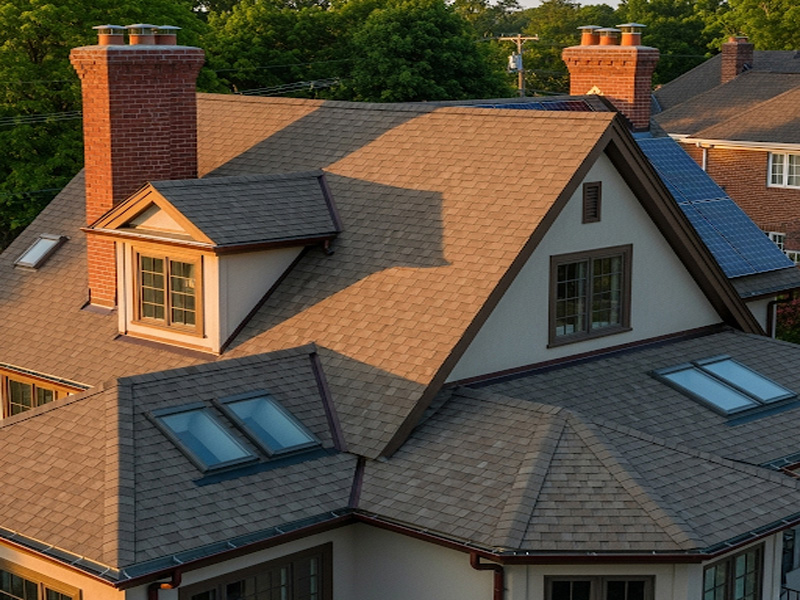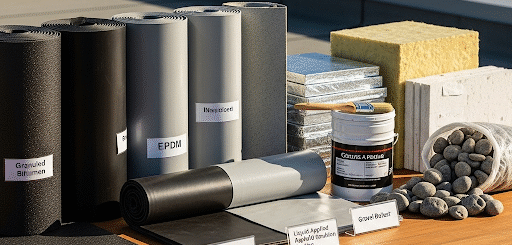Roof construction in the domestic sector

For detached houses in cold and temperate climates, domestic roof construction refers to the framing and roof covering. Generally, such roofs are made of wood, take a variety of shapes, and are covered with many different materials.
A roof being framed in 1955 in the United States
Typically, modern timber roofs consist of pairs of common rafters or prefabricated wooden trusses connected by truss connector plates. Principal rafters and timber roof trusses may be used to frame timber-framed or historic buildings. Based on the way they are designed and constructed with regard to thermal insulation and ventilation, roofs can also be classified as warm or cold roofs. A sloped roof’s pitch is determined primarily by the roof covering material and its aesthetic design. To shed water, flat roofs actually slope up to approximately ten degrees. The majority of flat roofs on houses are found in arid climates.
It is important to hold the roof down during severe storms, such as those caused by cyclones or hurricanes. The roof, as well as the rest of the structure, must withstand the uplift forces of high winds. A metal tie is fastened to each rafter or truss to accomplish this. The problem usually does not arise in areas that are not subject to extreme weather conditions or high winds.
Normally, in the UK, concrete tiled roof rafters are spaced 600 mm (24 in) apart, roof battens 300 mm (12 in) apart, and ceiling joists 400 mm (16 in) apart. Typically, framing members are spaced sixteen or twenty-four inches apart in the United States, which uses imperial units of measurement.
For openings like chimneys or skylights, the roof framing may be interrupted. Typically, chimneys are designed with a water diverter called a cricket or saddle above them. A flashing seals the gap between the chimney and the roofing material.
Construction of a rafter roof
The top ends of the rafters usually meet at a ridge beam, but may also butt directly to another rafter to form a couple of rafters. A roof deck (also called sheeting or sheathing) is formed by horizontal laths, battens, or purlins mounted on the rafters to support the roof covering. Longer rafter spans are supported by heavier under purlins or purlin plates. To prevent the rafters from spreading and forcing the walls apart, tie beams, which may also serve as ceiling joists, are traditionally connected between the lower ends of opposite rafters. To add strength, collar beams or collar ties may be fixed higher up between opposite rafters. Buildings are supported by rafters, tie beams, and plates that transfer the weight of their roofs to their walls
Construction of a truss roof
It consists of a truss roof with tongue-and-groove sheathing. Natural ventilation is provided by the gap in the sheathing at the ridge.
There are many styles of pre-manufactured roof trusses available. Depending on the building, they are designed by the manufacturer.
Trusses made of timber can be constructed in a variety of styles using wood or metal joints. Rafters of heavy timber that are typically spaced 240 cm (8 feet) to 370 cm (12 feet) apart are referred to as principal rafters. There can be a combination of principal rafters and common rafters or a mixture of principal rafters and common purlins.
Design loads
The roof framing must support a structural load, including dead loads, its own weight, and the weight of the roof covering as well as environmental loads such as snow and wind. It may also be necessary to design flat roofs to accommodate live loads if people are going to walk on them. Building codes in the United States specify loads in pounds per square foot, which vary by region. The size and spacing of the rafters and trusses are determined by the load and span (distance between supports).
Roof covering
A roof’s primary purpose is to shed water, including its underlayment and roof covering. Roof coverings come in a variety of colors and textures as well as being an important part of the architecture. North American houses often have asphalt shingles on their roofs, but some also have metal roofs or other roof coverings. It is more common for Europeans to have tile or thatch roofs than Americans. It is possible to reduce air conditioning costs in hot climates by using roofing materials designed to reflect light.
Asphalt shingles are the most common roofing material in North America, accounting for 75% of steep slope roofs. It is also becoming more popular in Europe due to lower installation costs. The North American residential roofing market is dominated by asphalt shingles, which are typically less expensive than other materials.
In the southern US and Mexico, clay tile roofs are also very popular due to their longevity and ability to withstand hurricane winds.
There is a great deal of popularity for slate and tile roofs in Europe. The majority of slate roofs in Europe are over 100 years old, and do not require much maintenance / repair.
Ventilation and insulation
The temperature within the roof space must be regulated by roof space ventilation. It is possible for humidity to cause interstitial condensation within the roof fabric, causing structural damage, wet or dry rot, and destroying insulation if ventilation is not provided properly.
Due to tighter building envelopes with high performance windows and doors and no chimneys leading to the roof space, condensation within the roof space is much more of a problem today. A tighter envelope means the air temperature in buildings has risen. The warmer the air in a building, the more water vapour it can carry.
Due to high performance insulation and roofing membranes in the roof space, as the occupied part of the building has become warmer, the roof space has become colder.
Warm, moist air rises from below into the cold roof space, causing condensation as it drops below the dew point or touches any cold surfaces on the roof.
Almost all building materials are permeable to water vapour; brick, concrete, plaster, wood, and insulation are all susceptible to interstitial condensation. It is for this reason that UK Building Regulations require roofs to be ventilated, either with soffit vents, ridge vents, or replacement ventilation slates or tiles.
Making openings in the soffit and ridge to allow natural air flow is a common method of ventilating a roof. There are also ventilated exterior walls in this example, which is called rainscreen construction.
A properly ventilated roof deck speeds the evaporation of water from leaks or condensation and removes heat, which prevents ice dams and prolongs the life of asphalt shingles. There is a minimum opening size of 1 square foot (0.093 m2) per 150 square feet (14 m2) according to U.S. building codes (1:150), with some conditions requiring a ratio of 1:300. The ceiling insulation is typically installed between the ceiling joists or rafters since warm air rises. When a roof is properly insulated and ventilated, it is called a cold roof. When the insulation is placed in line with the roof pitch on a warm roof, the roof is not ventilated[9]. If a roof is designed without ventilation and has enough air-impermeable insulation in contact with the sheathing to prevent condensation, it is called a hot roof. For example, spray foam insulation is applied directly to the roof deck or top side or in some cathedral ceilings.
Recent designs include a double-deck roof deck with foil-backed foam and an air-gapped second deck that allows air to flow vertically to a ventilation outlet at the peak of the roof.
Primitive roofing techniques
The roofs of houses in the Near East were constructed in the following manner from Roman times through the Middle Ages and into the 20th century. A wooden rafter was first positioned over the walls at a distance of about 60 cm between each rafter, followed by thin strips of wood (purlins), which were laid horizontally in close proximity to each other, and had a thickness of about three fingerbreadths (6.75 cm) each. They then attached a matting material made of natural plant fibers, such as cane reeds, rush or papyrus leaves, palm fronds, and tree bark, over these boards. After placing a thick layer of clay over this matting material, followed by a layer of soil of 20 centimetres (7.9 in), the top was then covered with a cement mixture of clay, rubble, and crushed potsherds. Wetness and rain downpours are not a problem for this kind of roofing material.
To support the ceilings in Sanaa, Yemen, twisted palm-leaf mats were woven over wooden beams. A wooden stick was laid at right angles to the beams to hold the mats in place. These crossing sticks were covered with mats, and above them bushes were spread. There was an overlay of lime or mortar over the wooden beams and mats. The thickness of the ceiling walls rarely exceeded 30 cm (12 inches), excluding the beams.
Ancient Gaul, Spain, Portugal and Aquitaine houses had peaked roofs made of mud lumps daubed with reeds and leaves, while other roofs were made of oak shingles or thatched. The Colchians in Pontus made their roofs by “cutting away the ends of crossbeams, and making them gradually converge as they lay them across, and bringing them up to the top from the four sides in the shape of a pyramid.” A roof in Marseilles was covered with leaves and mud, but at the time earth mixed with straw was used instead of tiles. Ancient Phrygians built a pyramidal roof of logs fastened together and covered with reeds and brushwood, on which mounds of earth were heaped high.

